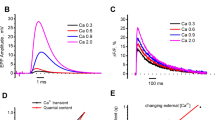Abstract
The effect of zinc on the release of transmitter was investigated in preparations of mouse diaphragm by conventional microelectrode techniques. The frequency (FP of miniature end-plate potentials (MEPPs), elevated by Ca2+ in high K+ medium, was reduced by zinc in a concentration-dependent fashion. When the extracellular concentration of Ca2+ ([Ca2+]o) was varied in the absence of zinc, a linear relationship between log(F) and log([Ca2+]o) was obtained. When the effect of zinc was depicted graphically, it was found that zinc shifted the relationship between log(F) and log([Ca2+]o) to the right, with respect to the control in the absence of zinc, without altering the slope. Zinc also reduced the quantal content (m) of end-plate potentials (EPPs). As [Ca2+]o was varied in the absence of zinc, a linear relationship between ln(m) and ln([Ca2+]o) was observed. Zinc shifted this linear relationship between ln(m) and ln([Ca2+]o) to the right, with respect to the control, without altering the slope. Thus, zinc reduced both the asynchronous and the phasic release of transmitter. These results suggest that zinc competes with Ca2+, and this conclusion is confirmed by examination of a modified Lineweaver-Burk plot of the data. Zinc probably inhibits the entry of Ca2+ into the nerve terminals, thereby inhibiting transmitter release.
Similar content being viewed by others
References
Balnabe RJ, Gage PW (1973) The inhibitory effect of manganese on transmitter release at the neuromuscular junction of the toad. Br J Pharmacol 47:339–352
Benoit PR, Mambrini J (1970) Modification of transmitter release by ions which prolong the presynaptic action potential. J Physiol 210:681–695
Cooke JD, Okamoto K, Quastel DMJ (1973) The role of calcium in depolarization-secretion coupling at the motor nerve terminal. J Physiol 228:459–497
Cooper GP, Manalis RS (1984) Cadmium: effects on transmitter release at the frog neuromuscular junction. Eur J Pharmacol 99:251–256
Cooper GP, Suszkiw JB, Manalis RS (1984) Presynaptic effects of heavy metals. In: Narahashi T (ed) Cellular and molecular neurotoxicology. Raven Press, New York
Crawford AC (1974) The dependence of evoked transmitter release on external calcium ions at very low mean quantal contents. J Physiol 240:255–278
Dodge FA, Rahamimoff R (1967) Co-operative action of calcium ions in transmitter release at the neuromuscular junction. J Physiol 193:419–432
Hubbard JI, Jones SF, Landau EM (1968a) On the mechanism by which calcium and magnesium affect the spontaneous release of transmitter from mammalian motor nerve terminals. J Physiol 194:355–380
Hubbard JI, Jones SF, Landau EM (1968b) On the mechanism by which calcium and magnesium affect the release of transmitter by nerve impulses. J Physiol 196:75–86
Jenkinson DH (1957) The nature of the antagonism between calcium and magnesium ions at the neuromuscular junction. J Physiol 138:434–444
Liley AW (1956) The effects of presynaptic polarization on the spontaneous activity at the mammalian neuromuscular junction. J Physiol 134:427–443
Lin-Shiau SY, Fu WM (1980) Effects of divalent cations on neuromuscular transmission in the chick. Eur J Pharmacol 64:259–269
Misler S, Hurlbul WP (1980) Tests of an electrostatic screening hypothesis of the inhibition of neurotransmitter release by cations at the frog neuromuscular junction. Biophys J 31:9–30
Pickett JB, Bornstein JC (1984) Some effects of lead at mammalian neuromuscular junction. Am J Physiol 246:C271–C276
Silbergeld EK, Fales JT, Goldberg AM (1974) The effects of inorganic lead on the neuromuscular junction. Neuropharmacology 13:795–801
Smart TG, Constanti A (1983) Pre- and postsynaptic effects of zinc on in vitro prepyriform neurons. Neurosci Lett 40:205–211
Weakly JN (1973) The action of cobalt ions on neuromuscular transmission in the frog. J Physiol 234:597–612
Author information
Authors and Affiliations
Rights and permissions
About this article
Cite this article
Nishimura, M. Zinc competitively inhibits calcium-dependent release of transmitter at the mouse neuromuscular junction. Pflugers Arch. 410, 623–626 (1987). https://doi.org/10.1007/BF00581322
Received:
Revised:
Accepted:
Issue Date:
DOI: https://doi.org/10.1007/BF00581322



